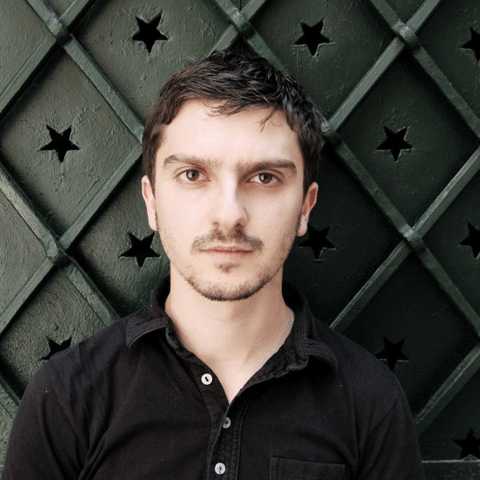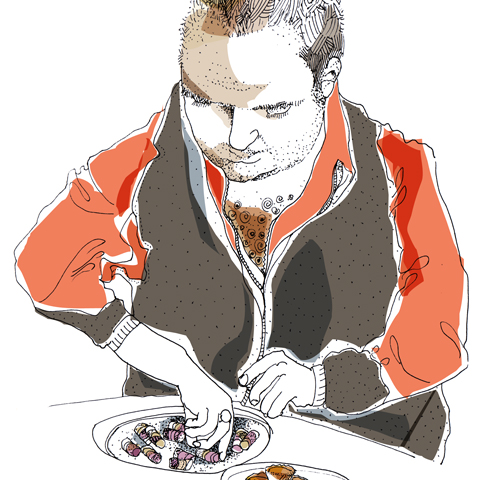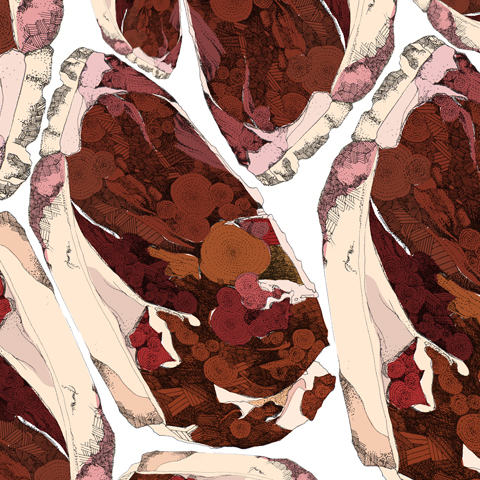Jared Schiller with David Byrne
All photographs and videos courtesy of Tate Shots except where otherwise stated.
Back in 2002 whilst still a skint student, cheapest I started what was then my idea of a dream job: ticket seller at Tate Modern and Tate Britain. I got to see great art and even meet the odd artist or two. I remember Gustav Metzger insisting he paid to see Barnett Newman, and Tony Oursler successfully blagging a freebie to the Turner Prize. Bridget Riley even gave us a personal tour of her exhibition. Fast forward five years and I’ve landed a job helping Tate Media launch a new video podcast: TateShots. These days I produce and commission the TateShots series, in which we interview artists about the business of making art, and talk to famous gallery-goers about their favourite art shows. The job has given me the opportunity to nervously meet heroes of mine like Jeff Koons, Laurence Weiner and Martin Creed, as well as artists I’m less familiar with but who become firm favourites.
We’ve made 150 episodes of TateShots so far, and it now comes out weekly. This week we launched a new strand called Sound & Vision. The series took the films’ director, Nicola Probert, and I, all over the country to interview musicians who make art. Billy Childish, Lydia Lunch, Mark E Smith, David Byrne, Jeffrey Lewis and Cosey Fanni Tutti all helped us with our enquiries about where art and music collide.
 Jared Schiller with Jeff Koons
Jared Schiller with Jeff Koons
Billy’s interview was probably the most memorable. We filmed him in a cramped bedroom he uses as a studio in his mum’s house in Whitstable, surrounded by stacks of paintings. There was hardly enough room for him to paint, let alone for us to film. Billy’s musical and artistic reputations arguably couldn’t be more different. As a musician he is cited by bands like The White Stripes as an influence – his dedication to lo-fi recording and performance make him the very definition of authentic. On the other hand, as an outspoken critic of conceptual art, his standing in the art world is a little harder to pin down. Because of this big difference, Nicola had the idea to get Billy to interview himself. So Artist Billy asked Musician Billy questions (e.g. “Do I have an influence on you?” Answer: “No.”), and explains how he went through a ten year stretch of only painting to the music of John Lee Hooker (almost). The whole experience made me think that it’s only a matter of time before Billy Childish is unmasked as the ultimate conceptual artist…
Going forward I would love to make more videos about pop stars with a taste for art. Before we embarked on this series we had already spoken to Alex James from Blur about Ellsworth Kelly, and John Squire from the Stone Roses about Cy Twombly. Apparently Jay-Z is a massive Richard Prince fan, so perhaps he should be next on my list.
 Jared Schiller photograph courtesy of Simon Williams/O Production
Jared Schiller photograph courtesy of Simon Williams/O Production
What Jared likes:
Places: Moel-y-Gest, a hill near Porthmadog in North Wales
Food: Pizza. My dream is to build a pizza oven in my back garden. It will never happen but I keep hold of the dream..
Drink: An Islay Whisky is the perfect late night tipple.
Website: http://www.tate.org.uk (of course)
Music: Currently the new Four Tet album.
Books: Currently reading ‘Then We Came to an End’ by Joshua Ferris. I mainly have a weakness for any kind of exhibition catalogue or artist’s monograph.
Film: I’m looking forward to Chris Morris’s ‘Four Lions’.
Shop: Alter 109 is a really good men’s boutique in Greenpoint, Brooklyn.
Back in 2002 whilst still a skint student, order I started what was then my idea of a dream job: ticket seller at Tate Modern and Tate Britain. I got to see great art and even meet the odd artist or two. I remember Gustav Metzger insisting he paid to see Barnett Newman, ed and Tony Oursler successfully blagging a freebie to the Turner Prize. Bridget Riley even gave us a personal tour of her exhibition. Fast forward five years and I’ve landed a job helping Tate Media launch a new video podcast: TateShots. These days I produce and commission the TateShots series, viagra sale in which we interview artists about the business of making art, and talk to famous gallery-goers about their favourite art shows. The job has given me the opportunity to nervously meet heroes of mine like Jeff Koons, Laurence Weiner and Martin Creed, as well as artists I’m less familiar with but who become firm favourites.
We’ve made 150 episodes of TateShots so far, and it now comes out weekly. This week we launched a new strand called Sound & Vision. The series took the films’ director, Nicola Probert, and I, all over the country to interview musicians who make art. Billy Childish, Lydia Lunch, Mark E Smith, David Byrne, Jeffrey Lewis and Cosey Fanni Tutti all helped us with our enquiries about where art and music collide.
Billy’s interview was probably the most memorable. We filmed him in a cramped bedroom he uses as a studio in his mum’s house in Whitstable, surrounded by stacks of paintings. There was hardly enough room for him to paint, let alone for us to film. Billy’s musical and artistic reputations arguably couldn’t be more different. As a musician he is cited by bands like The White Stripes as an influence – his dedication to lo-fi recording and performance make him the very definition of authentic. On the other hand, as an outspoken critic of conceptual art, his standing in the art world is a little harder to pin down. Because of this big difference, Nicola had the idea to get Billy to interview himself. So Artist Billy asked Musician Billy questions (e.g. “Do I have an influence on you?” Answer: “No.”), and explains how he went through a ten year stretch of only painting to the music of John Lee Hooker (almost). The whole experience made me think that it’s only a matter of time before Billy Childish is unmasked as the ultimate conceptual artist…
<object width=”425″ height=”344″><param name=”movie” value=”http://www.youtube.com/v/4vF1X8-BTQo&hl=en_US&fs=1&”></param><param name=”allowFullScreen” value=”true”></param><param name=”allowscriptaccess” value=”always”></param><embed src=”http://www.youtube.com/v/4vF1X8-BTQo&hl=en_US&fs=1&” type=”application/x-shockwave-flash” allowscriptaccess=”always” allowfullscreen=”true” width=”425″ height=”344″></embed></object>
Going forward I would love to make more videos about pop stars with a taste for art. Before we embarked on this series we had already spoken to Alex James from Blur about Ellsworth Kelly, and John Squire from the Stone Roses about Cy Twombly. Apparently Jay-Z is a massive Richard Prince fan, so perhaps he should be next on my list.
What Jared likes:
Places:
Food: Pizza. My dream is to build a pizza oven in my back garden. It will never happen but I keep hold of the dream..
Drink: An Islay Whisky is the perfect late night tipple.
Website: http://www.tate.org.uk (of course)
Music: Currently the new Four Tet album.
Books: Currently reading ‘Then We Came to an End’ by Joshua Ferris. I mainly have a weakness for any kind of exhibition catalogue or artist’s monograph.
Film: I’m looking forward to Chris Morris’s ‘Four Lions’.
Shop: Alter 109 is a really good men’s boutique in Greenpoint, Brooklyn.
SHIFT Encounters was put together by the organisation Cape Farewell. Founded by David Buckland in 2001, medicine Cape Farewell has sought to move beyond the scientific debate of climate change by involving artists in provoking and engaging the public. I like this approach; it seems to be a really important way to start thinking more positively about how we respond to climate change and look to the future. It is often so easy to be mired in the worrying statistics that we forget that the future is not set on a fixed, view predetermined path, buy information pills but is something that, with a little imagination, we can shape and plan. Artists can help us make this leap. Illustrations by Diana Boyle of Rooftop Illustrations
Illustrations by Diana Boyle of Rooftop Illustrations
Last week I went to see the talk on architecture, bringing together practicing architects, lecturers and a technical consultant. The panellists were well chosen, each bringing to the table their own perspective and expertise so the discussion was refreshingly lively and the kind of group-think around an issue where everyone is already in agreement and no progress is made was happily avoided.

A wealth of arresting facts was presented. Any initial doubt about the importance of architecture when thinking about climate change was quickly dispelled with the striking estimate that over half of the energy used in the UK is through our buildings. Architects were keen to point to the importance of the users of buildings as well as the designs in achieving energy efficient architecture. Office workers have become accustomed to buildings using energy to maintain a constant temperature throughout the day (through heating and air conditioning) rather than regulating this themselves by putting on, or taking off, a jumper. So part of the change required is in people’s minds as well as the brick and mortar.

Perhaps most interesting were the personal stories told. One architect recounted how after an environmental assessment of their offices, he was shocked to discover that 60% of the energy use was outside of working office hours. This was due to the amount of energy required to maintain the servers which were left on constantly. Such surprising results show, I think, the usefulness of such assessments in getting our response to energy use in proportion. For example, we take care in changing light bulbs to energy efficient ones when perhaps we might be better off worrying about the massive amounts of energy needed to heat unused rooms.
The most enjoying part of the talk, however, was the audience’s contribution to the discussion. Once the debate was opened up, the focus quickly moved away from a preoccupation with the office environment, towards much broader questions. These were both more difficult and more exciting to attempt to answer. How is it possible to achieve the cultural shift required to reduce energy use in our homes? Should this shift be regulated by the government or is the only way through localised self organisation?

Provocatively, one disarmingly simple question was posed to the architects. Why talk about all these high profile new ‘zero-carbon’ building developments when what we need to do is not build more, but make the housing stock that we already have more efficient? I think this question cut to the heart of the debate and helped to illuminate some of the forces in play in trying to create more sustainable architecture. Whilst less glamorous than iconic new developments, and certainly a more tricky investment proposition, increasing the efficiency of the buildings we have already would surely be the most effective way of reducing the total energy use of our architecture.
Categories ,Alan Gillingwater, ,architecture, ,Cape Farewell, ,Climate Change, ,Diana Boyle, ,Rooftop Illustrations, ,Shift Encounters, ,Southbank centre
Similar Posts:
- Climate Forum Weekend: 14th-15th June
- Warm-up for Copenhagen!
- Earth Listings: 12 – 18 October
- Spitalfield’s talk by Dan Cruickshank
- Britain’s Got Refurbishment

















